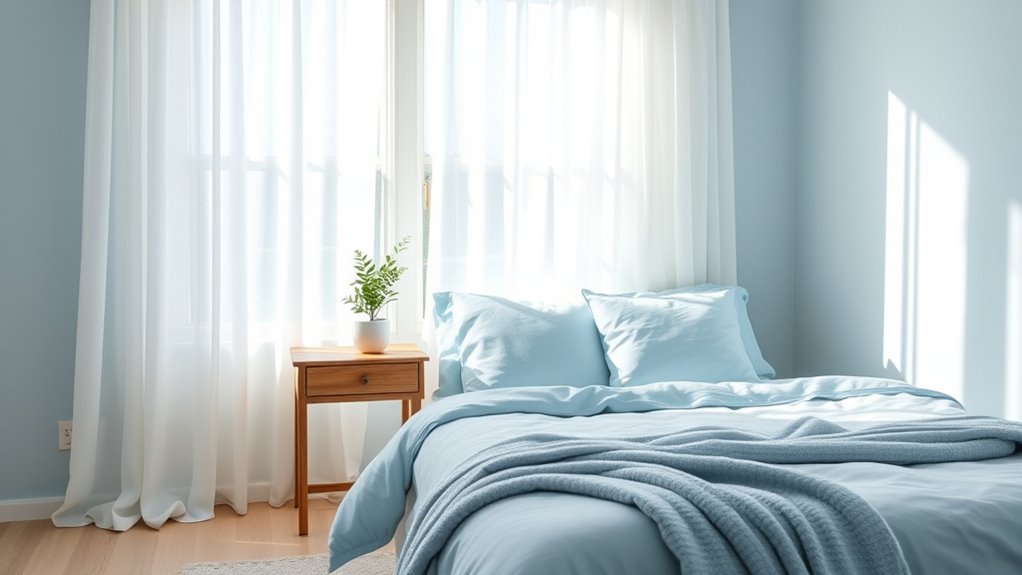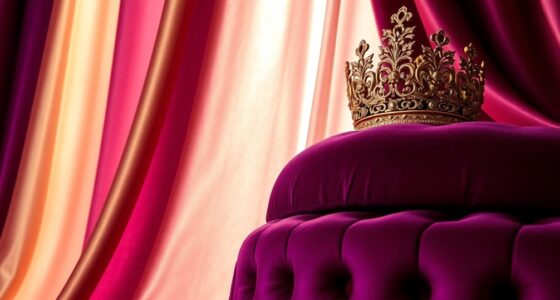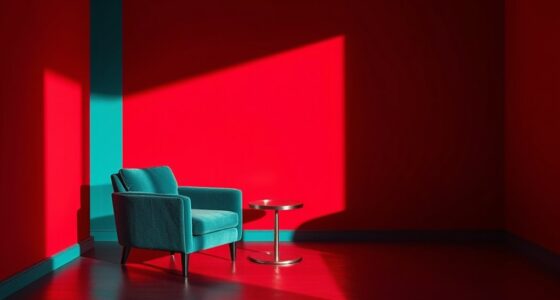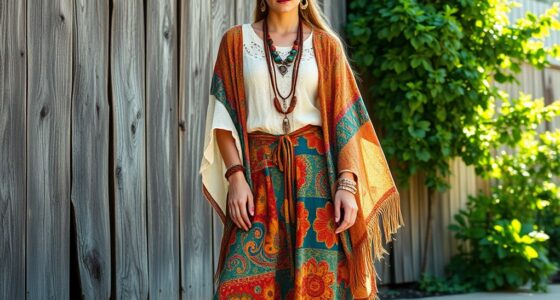Calm blue bedrooms create a soothing environment by tapping into the deep cultural and psychological roots of blue, which is associated with tranquility and protection. When you incorporate blue, it can boost your mood, lower stress hormones like cortisol, and promote relaxation and better sleep. Scientific studies show blue’s calming effects and its ability to reduce heart rates and anxiety. Keep exploring to discover how to choose the perfect shades and designs to make your space more peaceful.
Key Takeaways
- Blue hues trigger the release of mood-enhancing chemicals like serotonin and dopamine, promoting relaxation and emotional balance.
- Light blue shades foster calmness and serenity, reducing heart rate and cortisol levels, which lowers stress.
- Blue’s cultural symbolism of trust, safety, and spirituality reinforces feelings of security and tranquility in bedroom design.
- Incorporating blue tones can improve sleep quality by signaling the brain to unwind and promoting a peaceful environment.
- Scientific and historical evidence links blue to mental clarity, reduced anxiety, and a sense of well-being, enhancing overall relaxation.
The Origins of Blue in Interior Design
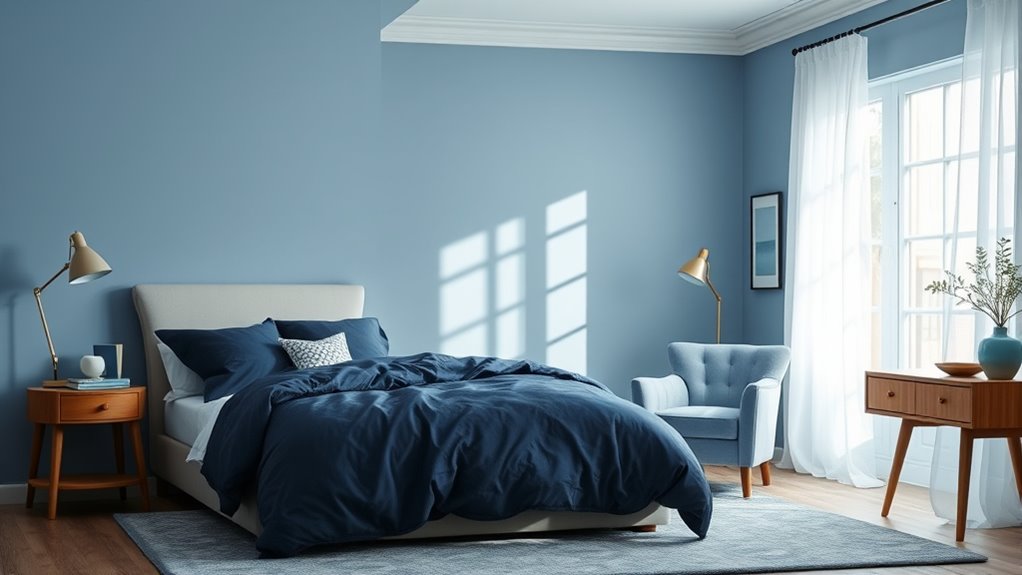
The use of blue in interior design dates back thousands of years, reflecting both cultural significance and technological advances. Historically, blue symbolized spirituality, protection, and status across various civilizations. Ancient Egyptians used natural pigment sources like lapis lazuli, a semi-precious stone, to create vibrant blue dyes for art and decoration. Similarly, the Byzantines developed techniques to produce ultramarine from lapis lazuli, making it a prized color for religious icons. In China, indigo dye from plants became a valuable natural pigment, spreading trade and influence. These early uses of blue reveal its deep symbolic meaning and the importance of natural pigment sources in crafting the color’s rich history. This foundation laid the groundwork for blue’s timeless appeal in interior spaces today.
How Blue Affects Brain Chemistry
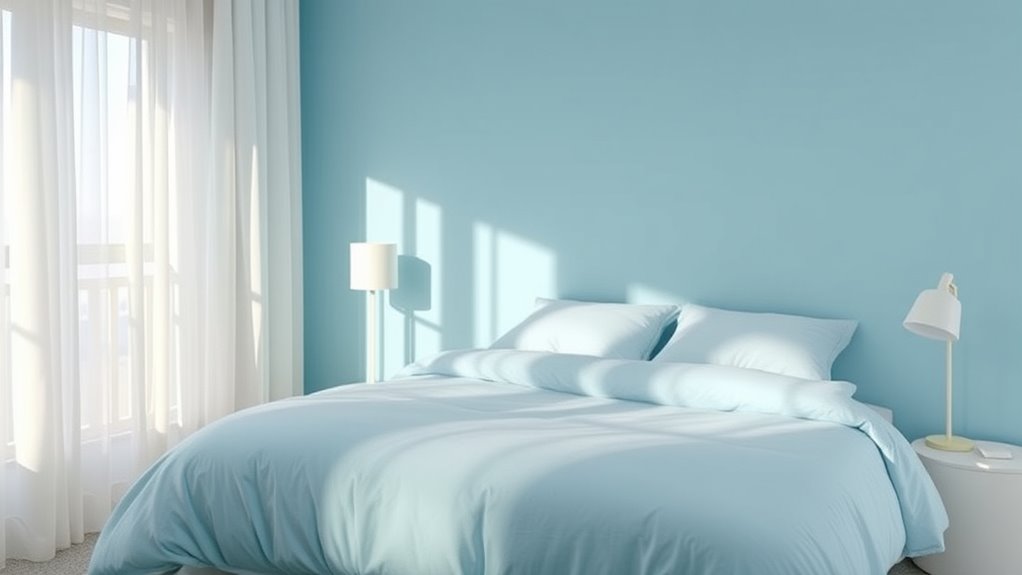
When you spend time in blue-colored environments, your brain responds by releasing chemicals that promote calmness and reduce stress. This is a core concept in color psychology, which explains how colors influence brain chemistry. Blue signals safety and tranquility, triggering the release of neurotransmitters like serotonin and dopamine that enhance your mood. These chemicals help lower cortisol levels, reducing anxiety. Here’s a breakdown of how blue impacts brain chemistry:
| Chemical | Effect | Role in Calmness |
|---|---|---|
| Serotonin | Mood regulation | Promotes feelings of well-being |
| Dopamine | Reward and motivation | Reinforces relaxation |
| Cortisol | Stress hormone | Reduced by blue environments |
| GABA | Inhibitory neurotransmitter | Enhances calmness |
| Oxytocin | Bonding and trust | Elevated in peaceful spaces |
This synergy explains why blue environments foster serenity. Additionally, engaging with environmental stimuli like blue decor can further reinforce these calming effects.
Blue and Its Role in Stress Reduction
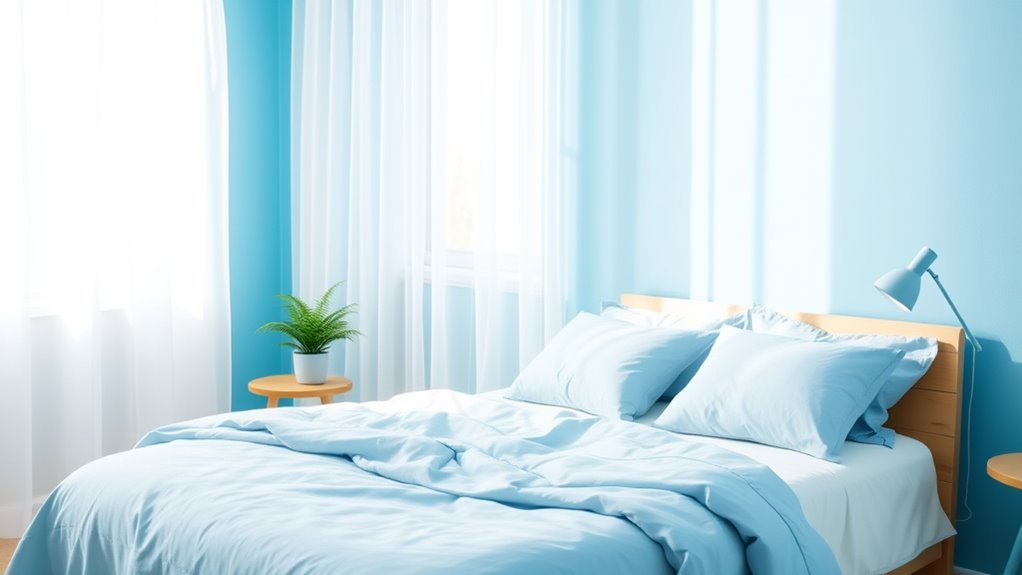
Blue creates a sense of tranquility and serenity that helps you feel calmer. It also lowers your heart rate, reducing stress levels. Plus, blue enhances focus and promotes a peaceful state of mind. Interestingly, the calming effect of blue is sometimes utilized in designing calm blue bedrooms to optimize relaxation.
Tranquility and Serenity
Because of its calming qualities, blue is often chosen for bedrooms to promote tranquility and serenity. Its color symbolism connects to feelings of peace, stability, and trust, making it ideal for restful spaces. Historically, blue has been used in art and architecture to evoke calmness and spiritual harmony, reinforcing its association with serenity. Ancient civilizations, like the Egyptians and Greeks, valued blue pigments for their soothing effects and symbolic meanings. Today, these historical associations continue to influence interior design choices, emphasizing blue’s role in creating a peaceful environment. When you select blue for your bedroom, you’re tapping into a deep-rooted sense of calm that has been valued for centuries, helping you feel more relaxed and centered in your personal space. Additionally, understanding the color psychology behind blue can enhance your ability to craft a truly restful retreat.
Lower Heart Rates
Research shows that exposure to blue hues in your bedroom can directly influence your physiological responses, helping to lower heart rates and promote relaxation. The calming effect of blue connects to maritime symbolism, evoking peaceful seas and tranquility. This color’s association with corporate branding emphasizes trust and stability, reinforcing a sense of security. When you surround yourself with blue, your body responds with reduced stress levels, making it easier to unwind. Here’s a quick comparison:
| Blue in Maritime Symbolism | Blue in Corporate Branding |
|---|---|
| Calm, vast oceans | Trust, professionalism |
| Safety, stability | Reliability, calmness |
| Serenity, peace | Confidence, clarity |
| Depth, reflection | Authority, steadiness |
| Tranquility, escape | Balance, reassurance |
This subconscious connection helps lower your heart rate, fostering overall relaxation.
Enhances Focus and Calm
When you incorporate blue into your bedroom, it can markedly boost your ability to focus and feel calmer. Blue’s color symbolism often associates it with tranquility, trust, and stability, helping to create a soothing environment. Cultural interpretations reinforce these feelings; many societies see blue as a calming hue that reduces stress and anxiety. This psychological association encourages relaxation, making it easier to concentrate on tasks or unwind after a busy day. Color accuracy and consistent lighting conditions further enhance the calming effect of blue tones by maintaining their true, peaceful hues. Blue’s cool tone acts as a visual cue for peace, promoting mental clarity and emotional balance. By choosing shades aligned with these symbolic meanings, you foster a space that naturally enhances focus while calming your mind, supporting overall stress reduction and mental well-being.
The Connection Between Blue and Better Sleep
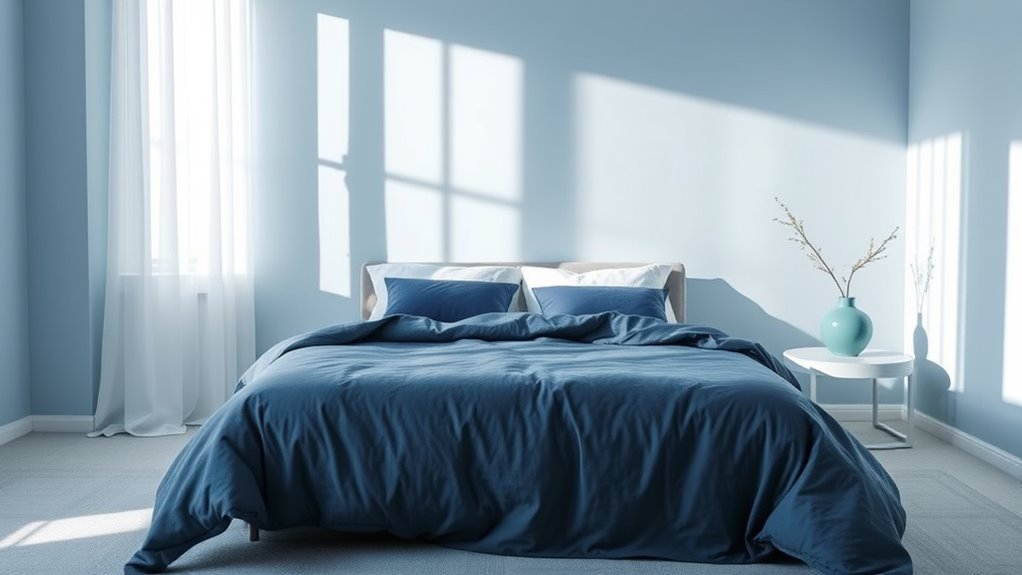
You might notice that blue creates a calming atmosphere in your bedroom, helping you relax before sleep. This color’s soothing effect can reduce anxiety and promote a sense of peace. As a result, your sleep quality often improves when your space features shades of blue. Incorporating relaxation techniques alongside the color scheme can further enhance your ability to unwind and achieve restful sleep.
Blue’s Calming Effect
The color blue has a natural calming quality that can considerably improve your sleep quality. Its soothing effect stems from its strong connection to tranquility in color symbolism and its historical uses in calming rituals. Blue’s calming effect helps lower stress levels and creates a peaceful environment, ideal for rest.
Consider how blue’s serene vibe influences your mind:
- Promotes relaxation and reduces anxiety
- Encourages a sense of stability and trust
- Mimics the sky and ocean, fostering a calming atmosphere
- Has been used in ancient cultures to promote peace and meditation
Sleep Quality Enhancement
A blue bedroom can considerably improve your sleep quality by creating a calming environment that promotes relaxation. The color symbolism of blue evokes tranquility and serenity, which can help lower stress levels and prepare your mind for rest. Interior design trends increasingly favor blue shades for bedrooms because they foster a peaceful atmosphere conducive to better sleep. Choosing soft, muted blues aligns with this trend, enhancing the room’s soothing effect. Additionally, incorporating elements like lightweight frames can contribute to a more comfortable and adaptable bedroom setup, reinforcing the calming ambiance. By incorporating these hues, you signal to your brain that it’s time to unwind, making it easier to fall asleep and stay asleep through the night. Overall, blue’s connection to calmness and relaxation plays a crucial role in sleep quality enhancement, supporting restorative rest every night.
Psychological Benefits of Calm Blue Environments

Calm blue environments can substantially boost your psychological well-being by promoting relaxation and reducing stress. The color symbolism of blue naturally evokes feelings of tranquility and safety, encouraging positive emotional responses. When you surround yourself with blue hues, your mind often associates the space with calmness and clarity, helping to lower anxiety levels. These environments can also improve focus and mental clarity, making you feel more balanced. Additionally, the association of blue with emotional stability can further enhance your overall mental health.
Cultural Significance of Blue in Different Societies

Across various cultures, blue holds profound symbolic meaning that shapes its use and perception. In many societies, blue represents trust, loyalty, and stability, influencing how it’s incorporated into everyday life. For example, in Western cultures, blue is often associated with calmness and professionalism, shaping societal perceptions of reliability. Conversely, in some Middle Eastern traditions, blue is believed to ward off evil spirits, giving it protective cultural symbolism. In Asian cultures like China, blue signifies immortality and spirituality. These diverse meanings impact how blue is used in art, clothing, and architecture, reflecting deep-rooted cultural values. Additionally, color symbolism plays a significant role in how societies interpret and utilize the color blue across various contexts. By understanding these societal perceptions, you can appreciate why blue evokes such a calming and meaningful response across different backgrounds.
Choosing the Right Shade of Blue for Your Bedroom
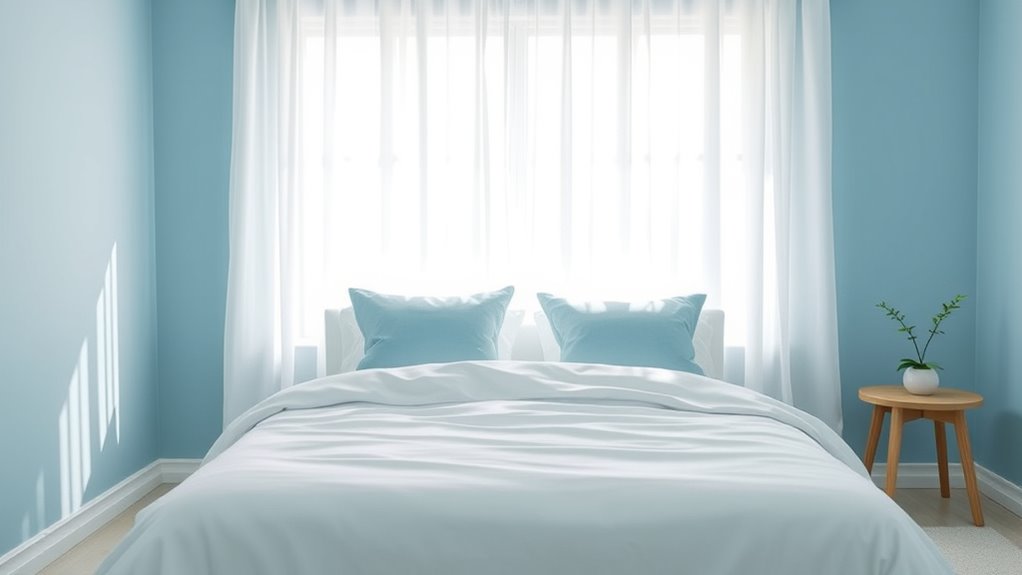
Since blue carries such rich cultural symbolism, selecting the right shade for your bedroom can enhance its intended atmosphere. When considering color psychology, your shade selection influences how relaxed or energized you feel. Lighter blues, like sky or pastel shades, promote calmness and serenity, perfect for sleep. Darker blues, such as navy or indigo, evoke sophistication but can feel less restful if overused. Bright or vibrant blues energize a space but may disrupt relaxation if too intense. To choose wisely, think about the mood you want to create and how each shade interacts with natural light. Keep these points in mind:
Choosing the right blue shade can transform your bedroom into a tranquil, elegant, or energizing space depending on your mood.
- Lighter shades foster tranquility
- Darker shades add depth and elegance
- Bright blues boost energy
- Muted tones support relaxation
- Understanding color psychology can help you select shades that promote the desired mood.
Incorporating Blue to Enhance Mood and Relaxation
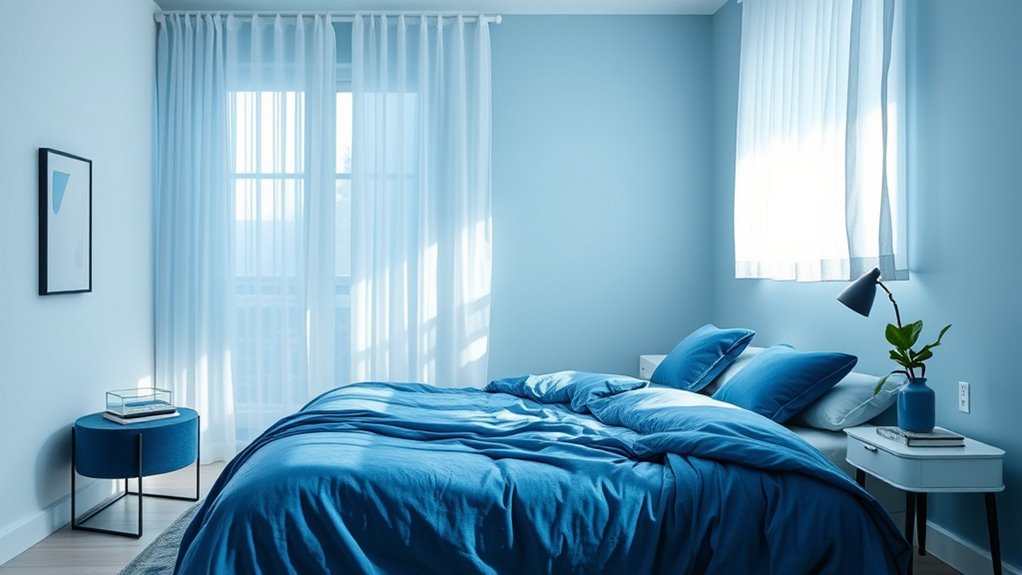
Incorporating shades of blue into your bedroom can substantially boost your mood and promote relaxation. Color psychology shows that blue evokes calmness and tranquility, making it ideal for creating a peaceful environment. To enhance your interior aesthetics, consider how different blue tones interact with your space. Visualize this:
| Soft Sky Blue | Deep Navy Blue |
|---|---|
| Brightens your space | Adds sophistication |
| Instills serenity | Encourages introspection |
| Perfect for walls | Ideal for accents |
Choosing the right shade helps set the mood, whether you want a light, airy feel or a more grounded, cozy atmosphere. Understanding color psychology can help you select hues that align with your desired emotional response. By thoughtfully integrating blue, you craft a space that fosters relaxation and aligns with your emotional well-being.
Scientific Studies Supporting Blue’s Calming Effects

Numerous scientific studies have demonstrated that blue hues can substantially reduce stress and promote relaxation. Researchers have found that exposure to blue light lowers heart rates and decreases cortisol levels, supporting blue’s calming effects. The color symbolism of blue—representing tranquility and stability—aligns with its historical usage in sacred and meditative environments. This consistent pattern across cultures underscores blue’s universal association with peace.
Numerous studies confirm blue’s calming power, lowering stress hormones and fostering tranquility across cultures.
- Blue’s calming effects are backed by studies on color psychology and physiological responses
- Historical usage of blue in religious and healing practices highlights its soothing qualities
- Research shows that blue environments foster focus and reduce anxiety
- Color symbolism links blue to serenity, reinforcing its role in creating restful spaces
These scientific insights confirm why blue bedrooms foster calmness and well-being.
Frequently Asked Questions
How Does Blue Influence Emotional Well-Being Beyond Relaxation?
Blue influences your emotional well-being by promoting feelings of trust and calm, thanks to color psychology. Beyond relaxation, it can help reduce stress and improve sleep quality, making you feel more balanced and centered. When you surround yourself with blue, you’re likely to experience greater mental clarity and emotional stability. This color’s soothing effects extend beyond just relaxation, supporting your overall mood and well-being throughout the day.
Are There Specific Blue Shades That Are More Effective for Calming?
The proof is in the pudding when it comes to shade selection; certain blue shades truly work better for calming. Light, soft shades like sky blue or powder blue are most effective, aligning with color psychology to foster tranquility. Deep navy or vibrant cobalt can have a more energizing effect. Focus on these calming shades to create a serene atmosphere that promotes relaxation and peace in your space.
Can Blue Bedrooms Help Reduce Anxiety or Depression Symptoms?
Blue bedrooms can help reduce anxiety and depression symptoms through the principles of color therapy, which promotes relaxation. You might find that a calming blue hue enhances your sleep quality, making it easier to unwind and feel more at ease. By creating a soothing environment, you’re likely to experience less stress and improved mood, as the color works naturally to promote calmness and emotional stability.
How Does Blue Compare to Other Calming Colors Like Green or Lavender?
Did you know that blue is often rated as the most calming color? Compared to green and lavender, blue’s cool tone promotes relaxation, especially when paired with neutral colors. Your color pairing choices can influence how you feel, as cultural associations link blue with trust and tranquility. While green symbolizes growth and lavender evokes serenity, blue’s consistent calming effect makes it a versatile choice for creating a peaceful space.
What Are Common Mistakes to Avoid When Decorating With Blue?
When decorating with blue, avoid overusing dark shades, which can make your space feel gloomy rather than calming. Also, steer clear of inconsistent color schemes that clash or seem disorganized. Instead, balance deep blues with lighter tones and cohesive accents. Keep your palette harmonious to create a serene environment. By avoiding these mistakes, you’ll foster a tranquil bedroom that feels both inviting and peaceful.
Conclusion
By embracing calming blue in your bedroom, you create a sanctuary where your mind can drift like a gentle ocean wave. This soothing hue taps into your brain’s natural desire for peace, helping you relax, reduce stress, and sleep better. Think of blue as a soft, comforting blanket wrapped around your senses, inviting serenity and renewal. When you choose the right shade, you turn your space into a tranquil haven that nurtures your well-being every night.
